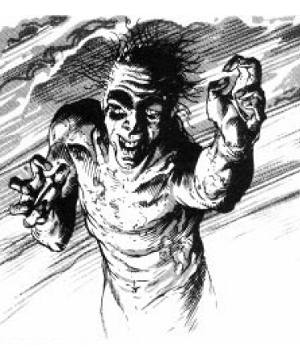

2105

| Climate/Terrain: | As creature or person mimicked |
|---|---|
| Frequency: | Very rare |
| Organization: | As creature or person mimicked |
| Activity Cycle: | As creature or person mimicked |
| Diet: | Nil |
| Intelligence: | As creature or person mimicked |
| Treasure: | Nil |
| Alignment: | Chaotic evil |
| No. Appearing: | 1-4 |
| Armor Class: | 3 |
| Movement: | As creature or person mimicked |
| Hit Dice: | 8 |
| THAC0: | 13 |
| No. of Attacks: | 1 |
| Damage/Attack: | 1-10 or by weapon (illusionary) |
| Special Attacks: | -1 bonus to initiative roll |
| Special Defenses: | Nil |
| Magic Resistance: | See below |
| Size: | As person or creature mimicked |
| Morale: | Very steady (14) |
| XP Value: | 2,000 |
Dreamwraiths are violent creations of the subconscious. They assault the minds of their victims through powerful illusionary attacks.
A dreamwraith can appear in a number of forms, usually humanoid, but almost always frightening and repulsive. It often takes the form of the dead, decaying visage of a character�s former friend or ally. Dreamwraiths are normally encountered as a result of a mindspin spell (see following).
Combat: Although their forms can vary, the AC and Hit Dice of dreamwraiths are always the same. Dreamwraiths despise all non-illusionary creatures of good or neutral alignment and are devoted to their destruction. Intelligent and cunning, dreamwraiths strike with surprising fury, often catching their victims off-guard. Dreamwraiths gain a -1 bonus to all initiative checks.
Occasionally, a character may encounter a dreamwraith with the ability to cause despair. Such a dreamwraith will tell the character a tale of hopelessness and discouragement. If the character succeeds in a saving throw vs. spell, he resists the hypnotic effect of the dreamwraith�s words. If he fails the saving throw, the character is overwhelmed with despair. He joins the dreamwraith, repeating the litany of hopelessness. Only a dispel magic spell or a convincing speech about hope and courage can negate the despair. There is a base chance of 30% that the speech negates the despair. At the DM�S discretion, the base chance may be modified as much as +70% if the speech is particularly inspiring.
The chilling touch of a dreamwraith inflicts 1d10 points of damage. They also employ a variety of weapons, most often long swords, battle axes, and daggers. However, the damage from both the touch and the weapons is illusionary, equal to 1 hit point of real damage per 4 points of illusionary damage. As with the illusionary damage of a dreamshadow, a character suffering illusionary damage perceives the damage to be real, �dying� when he believes he has suffered a fatal amount of damage. The illusionary nature of the damage is apparent only after the dream has ended.
Dreamwraiths take normal damage from a character�s weapons and spells, ceasing to exist when reduced to 0 hit points.
Dreamwraiths have normal magic resistance in the first level of mindspin dream, 10% magic resistance in the second level, and 20% in the third level. Because they are not undead, they cannot be turned.
If a dreamwraith is disbelieved before it conducts its first attack on a character, the character suffers no illusionary damage. A character cannot disbelieve a dreamwraith once he has suffered illusionary damage from it.
Disbelieving Illusions: A character can attempt to disbelieve dreamwraiths and dreamshadows. Each disbelief attempt requires the following steps:
Concentration Modifiers for Illusion Disbelief
| Time | Modifier |
|---|---|
| 1 round | +1 |
| 2 rounds | +2 |
| 3 rounds | +3 |
| 4-6 rounds | +4 |
| 7-9 rounds | +5 |
| 1-3 turns | +6 |
| 4-6 turns | +7 |
| 1+ hours | +8 |
Habitat/Society: A dreamwraith ceases to exist when the dream in which he resides has ended.
Ecology: Dreamwraiths experience only illusionary physiological functions. They are shunned by illusionary creatures of all alignments, but often ally with other dreamwraiths as well as evil dreamshadows.
Last Modified: September 02, 2009, 11:58:50 GMT

◆ 537 ◆